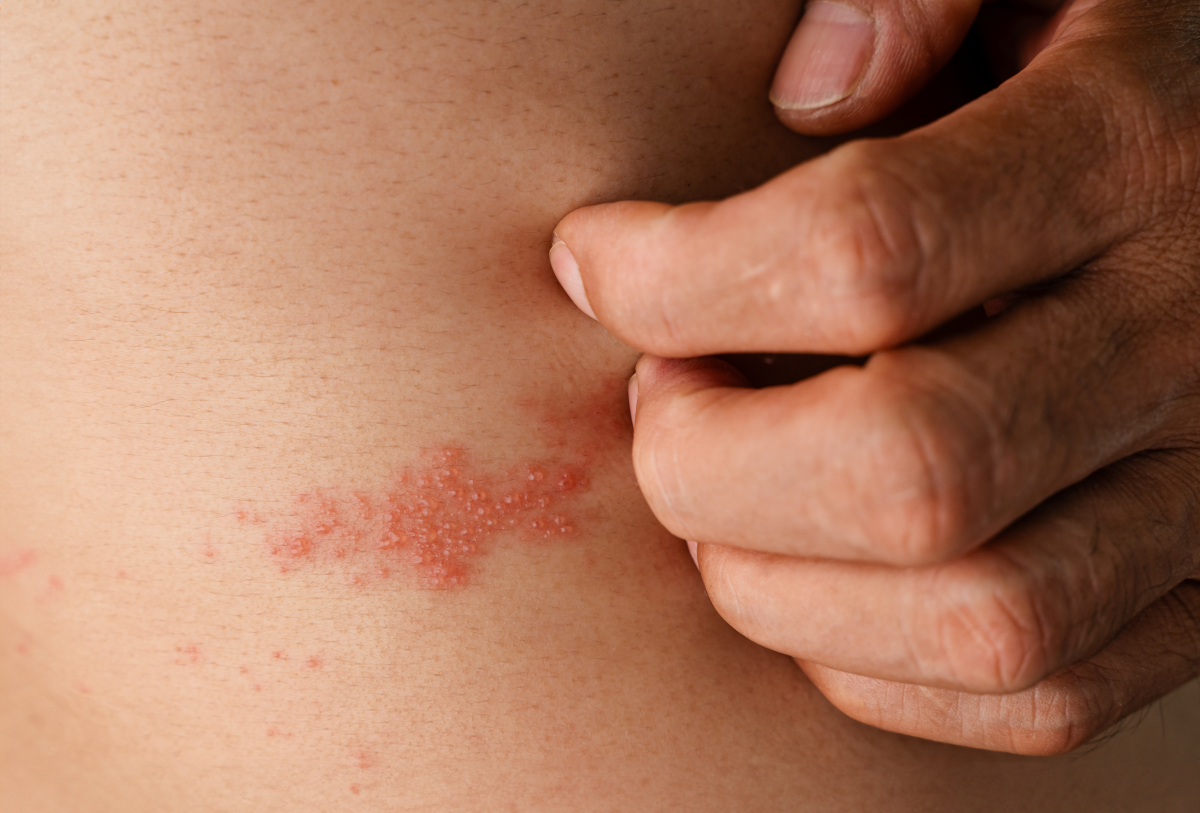Skin rashes are a common skin health issue that most people experience, but not all rashes are the same. According to Dr. Karaneh “Karen” Karimi of U.S. Dermatology Partners Plano, “Most acute rashes are harmless and are most often caused by things like allergies, sun exposure, or excessive heat. However, some rashes can be caused by infections, which may require more immediate attention and treatment. Infectious skin rash is commonly bacterial in origin and can lead to serious skin health complications if not treated promptly.” In this blog, Dr. Karimi answers common questions like what are bacterial skin rashes, what causes them, and what happens if you ignore them?
What Is a Bacterial Skin Rash?
While the skin is covered in bacteria at baseline, a bacterial skin rash occurs when there is improper invasion of harmful bacteria, such as Staphylococcus aureus or Streptococcus pyogenes. These bacteria cause a variety of rashes, ranging from mild irritation to skin infections, like impetigo, cellulitis, erysipelas, folliculitis, or abscesses. Bacterial skin rashes typically do not improve on their own; they are expected to worsen over time without proper treatment and may even develop into more serious conditions like necrotizing fasciitis, or sepsis. This is why it’s critical to seek medical attention if you suspect your rash is bacterial.
Early Symptoms of a Bacterial Skin Infection
According to Dr. Karimi, “Recognizing the early symptoms of a bacterial skin rash is key to preventing further complications. If you notice symptoms that indicate a bacterial infection, it’s essential to consult a dermatologist as soon as possible.” These symptoms may include:
- Redness and inflammation – the skin around the rash may appear red, swollen, and irritated, and it may feel warm to the touch, tender, or painful.
- Pain or burning sensation – the rash can be sensitive to touch, and the affected area may feel as if it is burning or stinging.
- Pus-filled blisters or crusting – as the infection worsens, you might notice yellow-orange crusting or fluid-filled bumps. This could be a sign that the infection is progressing and needs medical intervention.
- Rapid spreading or red streaks – if the rash starts to spread quickly or you notice red streaks running away from the rash, this is a sign that the infection may be worsening and could be spreading through the bloodstream.
- Skin that feels hot to the touch – this indicates the infection is deepening and involves inflammation beneath the surface of the skin.
What Happens if You Ignore a Bacterial Skin Rash?
Ignoring a bacterial skin rash may lead to several dangerous complications. While many rashes are mild at first, bacterial infections may escalate rapidly. Let’s take a closer look at some of the consequences of neglecting a bacterial skin rash:
1. Infection Can Spread Rapidly
Bacteria can multiply quickly, especially in warm, moist environments. If the infection is not treated, it can spread to other parts of the skin, deeper tissues, or into the blood stream. Redness and swelling may increase, and infection may spread to new areas. In severe cases, bacteria may enter the bloodstream, leading to a condition known as sepsis, which is life-threatening and requires immediate medical attention.
2. Risk of Cellulitis
Cellulitis is a serious bacterial infection that affects deeper layers of skin and surrounding tissues. It causes extreme pain, fever, and significant swelling. If left untreated, cellulitis may progress and lead to more serious complications, such as abscesses or systemic infections that affect other parts of the body. In some cases, cellulitis may require hospitalization to administer intravenous antibiotics and prevent further complications.
3. Development of Abscesses
An untreated bacterial skin rash may lead to the development of abscesses. These are pus-filled lumps that form in the skin as a result of infection. Abscesses often require drainage and medical intervention to prevent the infection from spreading further. If abscesses are not treated properly, they can cause long-term damage and scarring.
4. Delayed Healing & Scarring
The longer a bacterial infection persists, the harder it becomes to treat. This delay in healing can cause significant pain and discomfort. Additionally, untreated bacterial skin rashes are more likely to leave permanent scars, which can be difficult to treat and may negatively affect the appearance. Prompt treatment significantly reduces the risk of scarring and leads to a faster recovery.
5. Life-Threatening Complications
If the causative bacteria penetrate deeper into the fascia, the infection can develop into necrotizing fasciitis, a rapidly progressing, life-threatening soft tissue infection that destroys skin, fat, and fascia (the connective tissue surrounding muscles), requiring emergency surgical and medical intervention, including IV antibiotics.
In severe cases, a bacterial skin infection can progress into sepsis, a life-threatening infection that develops when bacteria reaches the bloodstream. It can spread to vital organs, potentially causing organ damage or failure. Sepsis is a particularly dangerous complication of untreated bacterial infections, and it can result in death if not treated immediately. If your rash is worsening, spreading rapidly, or causing significant pain or fever, seek medical care right away.
Can You Treat a Bacterial Skin Rash at Home?
In some cases, mild bacterial skin rashes can be treated at home with simple care measures. However, Dr. Karimi says, “Even with the right at-home remedies, many bacterial skin rashes will still require prescription antibiotics. If your symptoms persist, worsen, or spread, it is crucial to see a dermatologist. The longer the infection is left untreated, the harder it will be to treat effectively.” Some effective at-home care steps for bacterial skin rash include:
- Washing the affected area – clean skin with gentle soap and water to prevent the infection from spreading.
- Keeping the rash covered – covering the rash with a clean bandage can prevent bacteria from spreading to other areas of the skin. It also protects the affected area from dirt and other irritants.
- Plain Vaseline or petrolatum – covering with plain Vaseline or petrolatum is best for minor cuts, scrapes, and wounds to prevent bacterial infection.
- Warm compresses – may help with small abscesses or boils by promoting drainage, reducing pain, and enhancing immune response.
- Topical antibiotics – mild cases of skin infection can be healed with topical antibiotic ointments; however, these are mostly available by prescription (such as mupirocin ointment). Many dermatologists advise against the use of over-the-counter antibiotic ointments like Neosporin (bacitracin + neomycin + polymyxin B) or other triple-antibiotic ointments, as these agents are commonly associated with allergic skin reactions and contact dermatitis.
When to See a Dermatologist?
You should schedule an appointment with a dermatologist if:
- The rash is spreading rapidly or develops red streaks running from the area.
- You develop additional symptoms, such as fever, chills, or body aches.
- The rash becomes painful, swollen, or filled with pus.
- The rash does not improve after 48 hours of at-home treatment.
- You have a weakened immune system due to conditions like diabetes, HIV, or cancer, which can make bacterial infections more dangerous.
By consulting a dermatologist for your skin rash, it can be determined whether the rash is bacterial, viral, or caused by another condition. The dermatologist will be able to prescribe the appropriate treatment, which may include oral or topical antibiotics if determined to be a bacterial infection. If necessary, they may perform an incision and drainage to treat any abscesses that have formed.
Could Your Rash Be Something Else?
Since rashes can have many different causes, it is essential to see a dermatologist to determine the root cause of your rash. Dr. Karimi says, “Bacterial infections account for a relatively small percentage (< 10-15%) of all skin rashes that are seen in general dermatology, therefore it is important to consider other causes of similar-appearing rashes. By determining the underlying cause of rashes in partnership with your dermatologist, you can receive the most effective treatment that is tailored to your specific condition.” Other etiologies of rash that can be differentiated from bacterial skin infection include but are not limited to:
- Allergic reactions – contact dermatitis or allergic reactions to skincare products, soaps, or fabrics
- Heat rash – hot and humid weather can cause sweat to get trapped in your sweat glands
- Fungal infections – conditions like ringworm or athlete’s foot are caused by fungal infections that can resemble bacterial rashes
- Autoimmune skin conditions – diseases like eczema or psoriasis can cause rashes that resemble bacterial rashes
Final Thoughts: Don’t Ignore a Bacterial Skin Rash
The final word from Dr. Karimi, “Bacterial skin rashes are not something that should be taken lightly. These infections may quickly worsen and lead to serious complications, including cellulitis, abscesses, or sepsis. If you notice a rash that is painful, spreading, or not improving with at-home treatments, don’t wait. Seek medical attention immediately. Ignoring a bacterial skin infection can result in prolonged pain, delayed healing, and permanent scarring. Fortunately, with proper treatment from a dermatologist, most bacterial skin rashes clear up quickly.”
Schedule a Dermatology Consultation
If you’re dealing with a suspicious or painful rash, schedule an appointment with a board-certified dermatologist at U.S. Dermatology Partners. Don’t hesitate. Early treatment can make all the difference in your recovery. Book an appointment with a dermatologist near you, using our online scheduling request form.
Find a location near me
or


